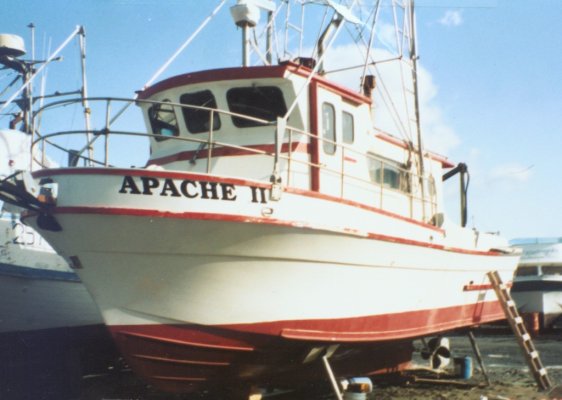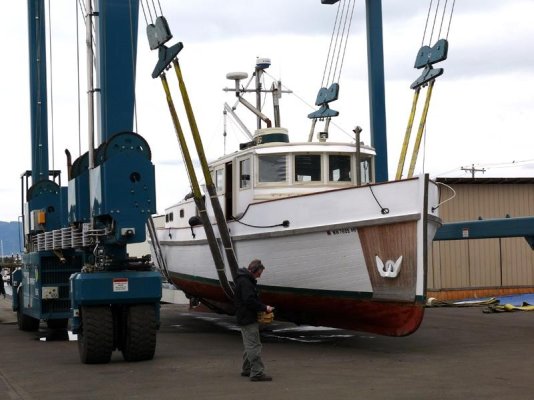skipperdude wrote:
Marin,
* I was underthe asumption *that a diesel should be loaded (WOT) *for at least 5 to 10 minuts for every 4 hours of operation. Do you ever load your diesel?
Never.* I was taught*a long, long time ago that a piston is only going to go up and*down so many times and the easier you make life on an engine (within the proper operating parameters) the*more times that piston will go up and down.
A fellow on the GB forum recently ran his engine (FL135) at WOT*for about 15 minutes, something he did regularly*on the advice of so-called diesel experts.* After this particular period of WOT operation the engine developed a loud metallic ticking sound, and the bottom line is*that during this WOT run there was metal transfer between the piston and the cylinder wall and there was heavy scoring on both surfaces.* He posted some photos and it wasn't pretty.* The engine is now out of the boat being rebuilt.
Now the root cause of this problem was not the fact he ran it at WOT for 15 minutes this particular time.* The engine obviously had one or more issues that caused this to happen-- localized overheating, poor lubrication--- I'm not a diesel mechanic so I can only speculate.
It iis also possible this problem would have developed eventually even at normal operating speeds and temperatures.* But until he ran it at WOT this particular time, the engine was running propery, smoothly,*and quietly (for a diesel) in the normal operating range*with no problems whatsoever.
So why stress something when there is no need to stress it?* Were we trying to escape pirates in our GB, sure, I'd run it WOT until we either got away,*were captured,*or the engines seized up.* But since pirates have yet to become a problem in the PNW, we run our FL120s within the recommended rpm band for this engine, which is 1500 to 1800 rpm, and we*never exceed it.* In the eleven years we have owned the boat the engines have been to WOT exactly once, and that for about three minutes to assess the maximum rpm with the props prior to having them reworked.
Today, eleven years after acquiring the boat, the engines only smoke lightly*for a few minutes at startup just as they did when we bought it.* (If an FL120 doesn't smoke at startup there's something wrong with it
* )*The port engine uses no oil in 100 hours and the starboard perhaps a half a quart, most of which is leaked out past a bad fuel pump seal I'm too lazy to change. Thye oil consumption figures have not changed in eleven years.
This isn't to say the engines won't self-destruct the next time we start them, but I was taught to not abuse machinery unless it was absolutely necessary.* As to the "run it hard to clean it out" theory,*the diesel mechanics and diesel engine design engineers I've asked about this have said that if the engine is run in the proper temperature range to begin with that*running it hard accomplishes nothing other than putting accelerated wear on the components and subjecting the engine to higher-than-normal heat.* Both of which do nothing to extend the number of times that piston is going to go up and down.
Keep in mind I*am not advocating underloading and running an engine at cylinder temperatures that are too low as that can be just as detrimental to the longevity of the engine*as going the other direction.
Some engines are intended for high-speed, high-load use, and as such that's the way they should be operated.* But the old thumpers--- like the FL120 that was designed in the 1950s--- were not intended for this kind of service.* In fact, this was a major cause of the failure of the FL120's base engine (the Ford of England Dorset engine) in the trucks it was designed to power.* The engine could not cope with the demands of ever-higher highway speeds, continuous acceleration and deceleration,*and heavier truck loads, and it proved to be extremely unreliable.* However it proved*very successful and reliable*in applications of relatively low loads and constant rpm--- industrial and agricultural applications.* The very attributes that made it ideal as a marine propulsion engine on boats like GBs and the like.
I have operated all my vehicles this way, some of which are as old as our boat, and all of the aircraft I have flown.* In the words of the best aviation mechanic and pilot I have ever known, "Be kind to your engine and it will be kind to you."


